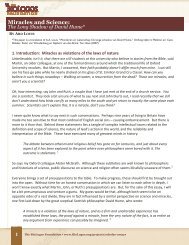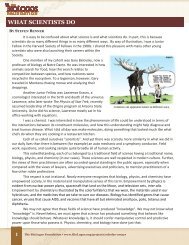Science and Faith at the Movies: “Avatar” - BioLogos
Science and Faith at the Movies: “Avatar” - BioLogos
Science and Faith at the Movies: “Avatar” - BioLogos
You also want an ePaper? Increase the reach of your titles
YUMPU automatically turns print PDFs into web optimized ePapers that Google loves.
The <strong>BioLogos</strong> Found<strong>at</strong>ion • www.<strong>BioLogos</strong>.org/projects/scholar-essays<br />
common Hollywood motif th<strong>at</strong> shows up in movies such as Pocahontas, <strong>and</strong> Dances with Wolves, which<br />
portray peace-loving indigenous peoples <strong>at</strong> one with n<strong>at</strong>ure—a politically constructed fiction th<strong>at</strong> doesn’t<br />
bear out in historical reality. Depraved cultural traditions such as female circumcision, head hunting,<br />
cannibalism, human sacrifice, slavery, <strong>and</strong> bloodthirsty warring are commonly present in indigenous tribes<br />
unaffected by Western civiliz<strong>at</strong>ion throughout history. It is not civiliz<strong>at</strong>ion, but human n<strong>at</strong>ure th<strong>at</strong> is<br />
corrupt. The tragic reality of pagan culture is more like <strong>the</strong> bloodthirsty human sacrifice of Apocalypto than<br />
<strong>the</strong> oneness of all life of Av<strong>at</strong>ar.<br />
The o<strong>the</strong>r conceit of Av<strong>at</strong>ar’s mythology of oneness with n<strong>at</strong>ure is in its moral condemn<strong>at</strong>ion of<br />
humanity <strong>and</strong> be<strong>at</strong>ific<strong>at</strong>ion of n<strong>at</strong>ure. Like <strong>the</strong> noble savage, this is ano<strong>the</strong>r self-referential absurdity. If <strong>the</strong><br />
“circle of life,” th<strong>at</strong> is, <strong>the</strong> cycle of “e<strong>at</strong> or be e<strong>at</strong>en” is indeed a harmonious beauty, <strong>the</strong>n humans cannot<br />
be condemned for consuming n<strong>at</strong>ural resources, which is in effect e<strong>at</strong>ing <strong>the</strong> life of o<strong>the</strong>rs. Humans are just<br />
as much a part of n<strong>at</strong>ure as anything else, <strong>and</strong> moral condemn<strong>at</strong>ion of gluttonous excess <strong>and</strong> exploit<strong>at</strong>ion is<br />
arbitrary subjective manipul<strong>at</strong>ion by those being e<strong>at</strong>en. Blowing up trees, killing Na’vi, <strong>and</strong> consuming<br />
unobtainium is just as n<strong>at</strong>ural as Na’vi killing <strong>and</strong> e<strong>at</strong>ing viperwolves <strong>and</strong> Than<strong>at</strong>ors killing <strong>and</strong> e<strong>at</strong>ing Na’vi.<br />
Richard Dawkins’s infamous <strong>at</strong>heist description of n<strong>at</strong>ural selection as “blind, pitiless indifference” is<br />
exactly <strong>the</strong> description of Selfridge <strong>and</strong> Quaritch’s characters, so supporters of Dawkins should have<br />
nothing to complain about with <strong>the</strong>se villains. They are <strong>the</strong> incarn<strong>at</strong>ion of an <strong>at</strong>heist worldview where <strong>the</strong><br />
circle of life th<strong>at</strong> is n<strong>at</strong>ure is in fact hostile, “nasty, brutish <strong>and</strong> short,” destructive, “red in tooth <strong>and</strong> claw,”<br />
<strong>and</strong> full of thorns <strong>and</strong> thistles—which brings us to <strong>the</strong> war of cultural narr<strong>at</strong>ives: Earth <strong>and</strong> n<strong>at</strong>ure worship<br />
versus man’s dominion stewardship.<br />
ANCIENT/MODERN SACRED MYTHMAKING<br />
I believe th<strong>at</strong> <strong>the</strong> reason for Av<strong>at</strong>ar’s success lies in James Cameron’s skill as a mythmaker. Av<strong>at</strong>ar is<br />
essentially a postmodern pagan myth on <strong>the</strong> level of <strong>the</strong> Babylonian Enuma Elish or <strong>the</strong> Ugaritic Baal Cycle<br />
of ancient Mesopotamia. Like Av<strong>at</strong>ar, <strong>the</strong>se epic myths were tales of warring deities of n<strong>at</strong>ure embodying<br />
<strong>the</strong> claims of religious <strong>and</strong> political supremacy.<br />
Despite our very scientific modern culture, mythology still connects with our human hearts because<br />
it appeals to transcendence, th<strong>at</strong> is, a reality outside of <strong>the</strong> world th<strong>at</strong> gives meaning <strong>and</strong> purpose to our<br />
existence within <strong>the</strong> world. Humanity, cre<strong>at</strong>ed as it is in <strong>the</strong> image of God, craves transcendence regardless<br />
of our technological advancement. Unfortun<strong>at</strong>ely, as <strong>the</strong> apostle Paul revealed, th<strong>at</strong> craving for <strong>the</strong><br />
transcendent God is suppressed out of moral guilt (Rom. 1:18–21) <strong>and</strong> results in pagan worship of <strong>the</strong><br />
environment as <strong>the</strong> most primal n<strong>at</strong>ural instinct. Humanity exchanges <strong>the</strong> truth of God for a lie, <strong>and</strong><br />
worships <strong>and</strong> serves <strong>the</strong> cre<strong>at</strong>ure <strong>and</strong> cre<strong>at</strong>ion r<strong>at</strong>her than <strong>the</strong> Cre<strong>at</strong>or (Rom. 1:25).<br />
The b<strong>at</strong>tle between cultural narr<strong>at</strong>ives of worshipping Cre<strong>at</strong>or or cre<strong>at</strong>ion is an ancient one.<br />
Augustine was right (<strong>the</strong> church f<strong>at</strong>her, not <strong>the</strong> fictional character): <strong>the</strong> cre<strong>at</strong>ion narr<strong>at</strong>ive of Genesis 1<br />
teaches man’s rule over <strong>the</strong> environment (Gen. 1:26–28). Critics of Judeo-Christianity are right when <strong>the</strong>y<br />
suggest th<strong>at</strong> <strong>the</strong> Bible desacralized n<strong>at</strong>ure by draining <strong>the</strong> deity out of it, but wrong when <strong>the</strong>y conclude<br />
th<strong>at</strong> such <strong>the</strong>ology necessarily leads to destructive exploit<strong>at</strong>ion of <strong>the</strong> environment. Genesis also teaches<br />
man’s responsible stewardship over <strong>the</strong> earth (Gen. 2:15). God gave laws th<strong>at</strong> reinforced man’s<br />
responsibility toward his environment (Deut 20:19-20; Ex 22:6), <strong>and</strong> even blessed or cursed <strong>the</strong><br />
environment in response to Israel’s obedience or rebellion (Deut 7:12-15; 28:15-24). In paganism, man is<br />
<strong>the</strong> earth’s servant, but in <strong>the</strong> Bible, man is <strong>the</strong> earth’s steward.<br />
6<br />
<strong>Science</strong> <strong>and</strong> <strong>Faith</strong> <strong>at</strong> <strong>the</strong> <strong>Movies</strong>: “Av<strong>at</strong>ar”<br />
BY BRIAN GODAWA




